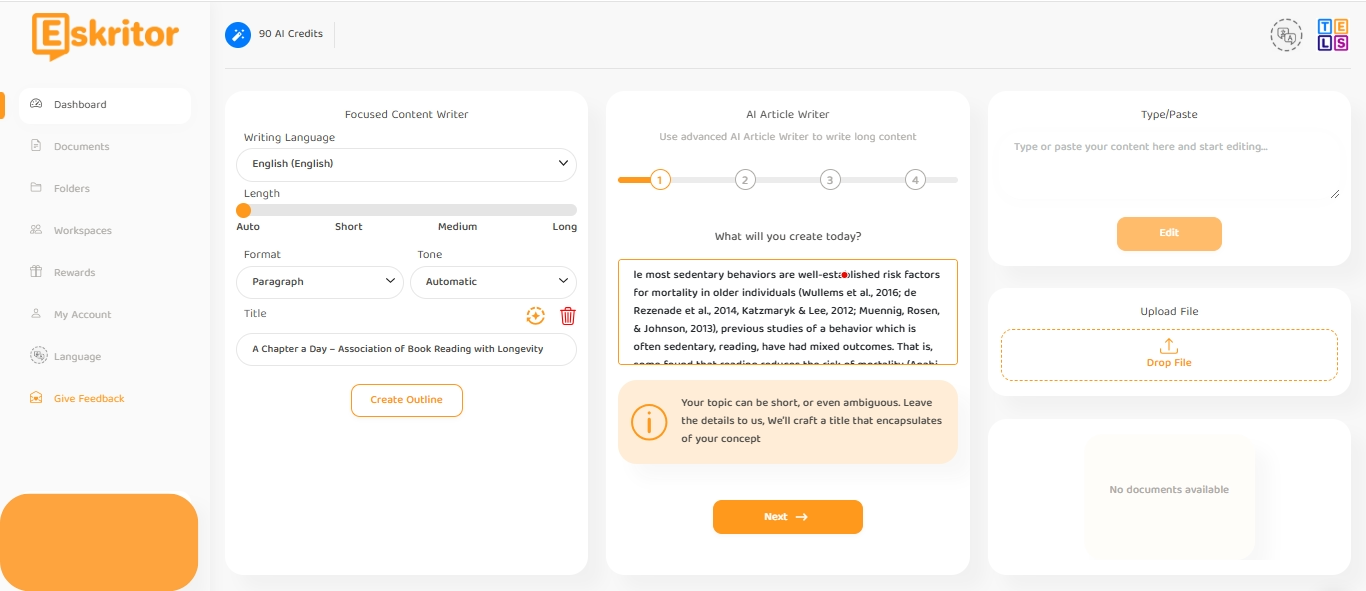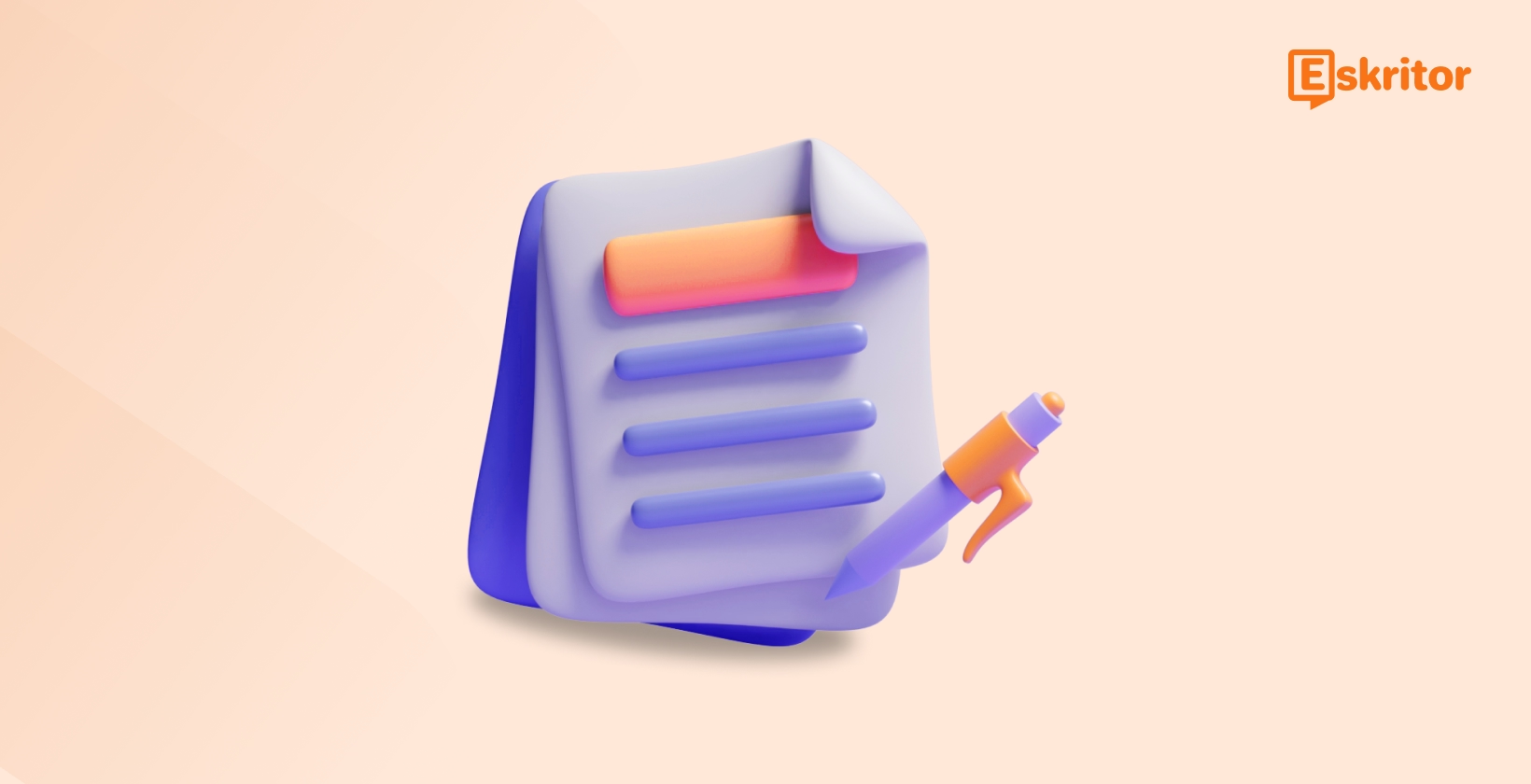A well-versed summary improves retention and saves time. Manual and AI-based summaries are two article compression methods. However, with the advent of AI, the latter is gaining popularity.
In this article summarization guide, you will discover how to summarize articles. Also, learn how to use Eskritor to create high-quality summaries in minutes.
Why Summarizing Articles Is Important
Summarizing articles is important to give the reader most of the information present in the original document. When summarizing a document:
- Ensure that no information skips during condensation.
There are extensive summarization applications, such as helping the reader quickly understand the content.

According to the study “Automated Summarization of Multiple Document Abstracts and Contents Using Large Language Models”:
- The summarization system, leveraging LLM, generated concise and coherent summaries from multiple document abstracts and titles.
- Domain-specific evaluations revealed superior performance in the healthcare and scientific fields.
Benefits for Students, Professionals, and Researchers
For students, summarization reduces the written text they need to understand and read. Once they master the art of summarization, they can improve their memory and become more skillful.
As Fei-Fei Li said, “Artificial intelligence is not a substitute for human intelligence; it is a tool to amplify human creativity and ingenuity.”
Summarization also helps students improve their focus by allowing them to focus more on phrases and keywords. According to a 2024 survey conducted in Indonesia, around 55 percent of respondents used AI tools for summarizing tasks.
Reference: Statista
- Summaries are essential in any government, business, academia, and trade profession.
- Companies that create summaries of business news help a broad spectrum of users.
- Summaries are crucial not only for information and management but also for the modern world.
Some examples include:
- Students: Summarization helps improve focus and retention, making study sessions more effective.
- Professionals: Saves time by condensing reports and documents into actionable insights.
- Researchers: Enables quick identification of relevant studies and key findings.
Any researcher working on a scientific article should focus on the presentation for relevancy and data. When concluding the article, a summary statement should include implications and future directions.
A study on “Effective deep learning approaches for summarization of legal texts” states:
- Automatic summarization in the legal domain can have a plethora of applications.
- This includes simplifying the work of lawyers plowing through a huge body of legal documents.
- Also, efficient retrieval of judgments relevant to a query.
Time-Saving Advantages in Work and Study
Whether a student or a working professional, summarizing your content can save you time. It also saves money and lifts the burden of uncertainty. Each study session can be productive for students when they summarize a story or concept after reading it.
- You can summarize your tasks or topics using notes, flashcards, or charts.
- There is no need to revisit the entire content every time if you already have a summary.
- Summarizing helps you find the key details in every paragraph.

Improving Comprehension and Retention of Key Points
If you have comprehensive content and wonder how to summarize articles, identifying key points makes it easier. It will help you focus on essential information as a reader. By removing unnecessary details, summarization makes the text easier to understand and memorize.
- Summarization improves the organization of content by grouping the related ideas.
- This aids comprehension by making the information more manageable and easy to review.
- Summarization reduces the amount of information to remember and helps readers retain it.
Simple Methods for Summarizing Articles Manually
Simple methods for summarizing articles include reading the article multiple times. It also includes dividing long articles into sections and describing the points in your own words.
Identifying Key Points and Main Ideas
To identify the main ideas, read the article several times to understand the information better. Use a tool to highlight the essential facts and reread the highlighted information. When you write your summary, paraphrase these highlighted facts and then write your summary.
- Another quick summary technique you can use is to group the ideas.
- In this technique, read the entire article and notice how the paragraphs are about a similar topic.
- Draw a line between each section, and if the article is longer, divide it into sections.
For each section, write a short phrase explaining the topic of that particular section. Once you have a list of phrases, use these to write your summary.
Using Outline Creation for Structured Summaries
You can create an outline or a summary chart to identify the main ideas in a summary. Create a grid and take notes for each section in that grid.
- Write the main ideas, and in another column, write the supporting ideas.
- Use these notes to write your summary and use some supporting ideas in the summary.
- Ensure that for a selective summary, you only use relevant information to the topic.
Tips for Writing Clear, Concise Summaries
A summary gives a concise overview of the main points in the text and is shorter than the original text. Here are some tips you can follow to write a clear and concise summary:
Read the Text
Read the article in three stages: scan, read, and skim to understand it thoroughly. By scanning, you get a sense of the topic. By reading, you can highlight important points and make notes. While skimming, you can confirm if you understand the key points.
Break it Down Into Sections
Other articles may not be explicitly divided into sections, unlike a scientific paper. Breaking the content down into smaller sections makes it more manageable.
Identify the Key Points in Each Section
By identifying the key points, you let the reader know what they need to understand in the article. A summary is not just paraphrasing but extracting essential points.
Write the Summary
Once you have the key points and understand how to summarize articles, put them down in your own words. This also helps to avoid plagiarism and show that you have understood the article. Do not copy-paste the article parts, but write out your understanding of the original content.

How AI Tools Like Eskritor Simplify Article Summarization
According to research, people tend to shift their focus after every 47 seconds. Some facts highlight how employers must adapt information organization for prospects and marketing.
People have a shorter attention span, so information overload can be a problem. Wherever required, companies must present short and summarized information.
In that case, an AI summary generator like Eskritor makes it easy to summarize long-form content. Summarizing articles with Eskritor allows you to free yourself up and focus on high-value work.
Overview of Eskritor’s Article Summarization Features
Eskrior is an AI writing software that helps you write, edit, and enhance content. It combines the strengths of a content writer, text editor, and writing assistant.
- You can use Eskritor to create social media content and write blogs, e-mail copies, and more.
- As an AI writer, Eskritor can enhance your ideas and meeting summaries into well-organized text.
- It can also condense lengthy content into short and clear summaries as a simplified content summarization tool.
Steps to Use Eskritor for Fast Results
AI article summarizers produce a reliable content summary in less time and with high accuracy. It also ensures that your summary stays plagiarism-free and is well-organized for understanding. Here are steps to use AI summarizers for fast results:

Step 1: Log in to Eskritor
Log in to Eskritor using your email or Google account. Once done, you will be redirected to the Eskritor dashboard.

Step 2: Insert the Prompt
In the “Focused Content Writer” section, write the content's title. You can select the format, length, and tone you want for the title. This section creates an outline of your content.
In the “AI Article Writer” section, you can follow a step-by-step process to create a summary.

Step 3: Let Eskritor create your Summary
Once you finish all the steps according to your needs, click on “Start writing.” Eskritor will create the content of your summary, following the steps you have selected.
Benefits of Automatic Text Summarization Tools
Summarization tools improve information retrieval by highlighting key points in a document. This helps you locate the information you need without searching through irrelevant information. By presenting the most critical information in an easy-to-understand format, Eskritor article summarizer can help improve comprehension.
Comparing Manual vs. AI-Based Article Summarization
In manual summarization, a human reader goes through the text, grasps the main points, and expresses them in condensed form. You can develop competency through language proficiency and subject matter knowledge.
AI-based summarization is among the quick article summary methods. Natural Language Processing (NLP) powers AI-based summary tools, which allow them to summarize content without human intervention.
Pros and Cons of Manual Summarization
Traditionally, manual summarization has been a popular method to summarize text. However, a large text volume makes it time-consuming and hard to work. Here are some pros and cons of manual summarization:
Pros:
- Captures nuances and subtle features.
- Involves human-level insight.
- Develop critical thinking and language skills.
- Adaptable based on specific criteria.
Cons:
- Challenging for large volumes of text.
- Requires significant effort.
- Not scalable for lengthy documents.
- May not be practical for ongoing summaries.
Efficiency and Accuracy with AI Summarizers
With the advent of AI, summarizing a long text has become more accessible. Now, you can skip spending long hours analyzing long-form content to highlight critical information. An AI text generator and summarizer like Eskritor can do this within minutes, providing the highest level of accuracy.

A good summary should always have precise wording; sometimes, finding words manually can be challenging. Using an AI-based text summarizer, you can find the best phrases to generate a text summary.
Which Method to Use Based on Your Needs
Automatic text summarization for articles is used in the legal industry, healthcare, and academia.
- It helps lawyers summarize lengthy legal documents and extract relevant rulings.
- Researchers use automatic text summarizers to summarize scientific articles to identify relevant points.
- In healthcare, summarization tools help doctors quickly review patient histories, saving critical time in emergencies.
- A survey held on AI and journalism in January 2024 in the United Kingdom found that 73 percent of respondents felt it acceptable for artificial intelligence to perform spelling and grammar edits to an article written by a human journalist.
Source: Statista
|
Aspect |
Manual Summarization |
AI-Based Summarization |
|---|---|---|
|
Speed |
Time-consuming |
Instantaneous |
|
Accuracy |
High, with expertise |
Moderate, depends on tool |
|
Scalability |
Limited |
Excellent |
|
Learning Opportunity |
Enhances critical skills |
Minimal |
Best Practices for Creating High-Quality Summaries
A high-quality summary is coherent, independent, and comprehensive. As mentioned before, it can isolate essential points from the original text. Once you review all the ideas, you can include them in the summary. Ensure you eliminate repetitions in your list and try not to restate the same points.
Ensuring Accuracy and Relevance in Summaries
To ensure accuracy and relevancy in a summary, avoid creating an overly lengthy summary that defeats the purpose.
- For example, it is unlikely that anyone reads a 15-page summary.
- You can use a template-style approach to focus on key topics relevant to the audience.
- This will provide a structured summary and keep the readers manageable.
Formatting Tips for Easy Readability
Summary formatting is crucial to capture the attention of busy professionals and decision-makers. A proper structure in your summary can make the difference between readers noticing or overlooking your report. Here are some formatting tips for easy readability:
- Keep it short and aim for a 1-2 page summary highlighting critical information.
- Start with a compelling hook and statistical data. This will immediately grab the attention of the reader.
- Use clear headings to organize your summary.
- You can include graphs and infographics to present complex data in an easy format.
- Highlight the critical discoveries in bold or bullet points.
Adapting Summaries for Different Audiences
Before you start writing, you need to identify your audience and your purpose. Your audience will be the people who read your report.
- The reason why you are writing the summary will define your purpose.
- The summary's format, style, and tone may vary depending on your audience.
- For example, if you are writing a summary report to your manager, you would use a professional tone.
Key Takeaways: How to Summarize Articles Efficiently
Every content should have an article summary and an overview highlighting the key points. A practical summary acts as a preview to help readers decide whether or not to read the full version.
- Summarizing saves time and helps you convey the main ideas.
- A bulleted list can be helpful when taking notes for a summary.
- You can ask questions such as what goal the article is trying to achieve and how it achieves it.
Recap of Effective Summarization Methods
In academic writing, you need to research the work of other researchers and develop your ideas. Before creating a summary, it is advisable to read the passage carefully to understand it fully.
- Two of the most effective summarization methods are manual and AI-based summarization.
- People commonly used manual summarization in the past.
- Now, AI-based summarization does the same thing faster.
Choosing the Right Tools for Quick Summaries
Before you learn how to summarize articles, it is essential to choose the right tools. Quick summaries not only save time but also ensure accuracy and relevancy.
For example, Eskritor allows you to generate text automatically with its AI content writer. Moreover, you can create your summary in over 60 languages. The software is easy to use and is perfect for marketers, bloggers, and professionals.
Conclusion
Understanding how to summarize articles is important to give the reader the most information. Summarization also helps students and professionals improve their focusing skills and productivity. Summary formatting is crucial to capturing the attention of the target audience.
Summarizing articles efficiently enhances productivity and comprehension across industries. Whether a student or a professional, tools like Eskritor can help you create concise, accurate summaries in minutes, start summarizing smarter. Try Eskritor today to save time and improve accuracy.





 Dubai, UAE
Dubai, UAE